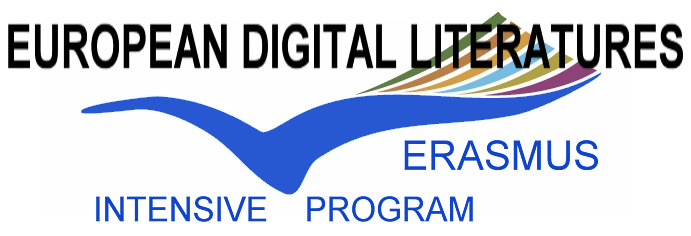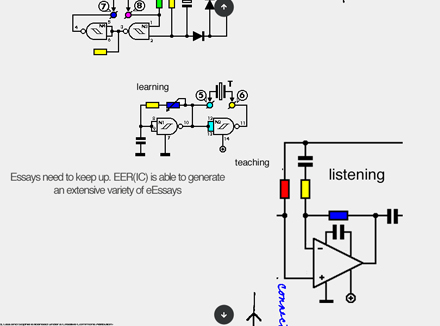EER(IC)
Team members:
How EER(IC) began
The Electric Essay Randomiser (Information Collapse), in short EER(IC), was conceived during the 2012 Erasmus Intensive Program, “European Digital Literatures”. Initially, it started out as a joke. After two weeks of constant theoretical input, we felt at the edge of a serious case of “information overflow”. Whilst analysing different works of art, we started joking about being able to nearly finish an essay and then just switching the topic to another work of art - leaving the analysis as it was and only correcting the title of the chosen subject throughout the preexisting argumentation.
Inspired by the theory we had been “fed” over a period of two weeks, the idea struck us. The highly Ergodic and Generative concepts played on our minds and we started working on this “joke”, transforming it into something serious. EER(IC) was born.
EER(IC)’s role
Living in the Digital Age, there is no end to the flux of information that presents itself in our daily lives. In the field of academia, sources of information are endless. With so many different theories and definitions, a strong sense of information overflow pervades the mind.
With so much information at hand, students’ academic works are in danger of becoming too shallow, too full of information; failing to truly resonate a definitive point.
In many cases, essays do not offer close-readings or deep analysis of a chosen aspect anymore. Instead, they are often just loosely connected lists of definitions on the subject of discussion.
By randomly putting together facts about Digital Literature that are somehow related to a chosen work of art, but at the same time not going in too deep for a “real” analysis, the machine reflects this trend. EER(IC) simulates trying to “write” an essay with too much information and an inability to distinguish relevant from irrelevant information on the discussed topic. This is achieved through the excessively informational and repetitive style of the generated essays.
Additionally, the fact that EER(IC) sometimes generates an essay full of fractions reflects on the tendency that there’s often too little time or motivation to revise academic works for the students.
Last but not least, it provokes thought about the originality of academic papers. If EER(IC) is able to generate an academic essay, where do we draw the line? Where does plagiarism begin, and what makes an essay personal?
All in all, EER(IC) is a tool to provoke thought about information processing and academic writing. The limitation on Digital Literature as a topic positions it as a kind of meta art; reflecting Digital Literature, its handling in academic contexts and EER(IC)’s own structure and ancestors.
The interface
EER(IC)’s interface is highly reflective of the concepts at play. The website design is not just a pretty face. More importantly, it refers to the way that EER(IC) works.
The background images are electric circuits, symbolising the process of information and context joining together to make a whole. In the same way, EER(IC) simulates the meeting of keywords and essay structure. The combination of visual movement and sound provides a metaphor for divergent entities contributing overall toward one product.
The bright colours help to construct a playful visual, making jest of how simple it is to create an academic essay using EER(IC). The variable palette serves as yet another metaphor for bringing a variety of components together and placing them alongside each other in one piece.
You may notice that the letter A makes a regular appearance. This is because, in Catalan, it symbolises generative text. With this in mind, it refers to the generative nature of EER(IC)’s output.
Overall, the interface represents EER(IC) as a randomised contributor of many components, all working in unison to create a whole.
How it works!
Welcome to EER(IC)! A pleasure to meet you. In case you didn’t know, Electronic Literature is completely changing the way we read. The printed word is being revolutionised. Essays need to keep up. Up-to-date and in-the-know EER(IC)’s ready to generate an unlimited variety of Electronic Essays for you.
How to use EER(IC):
Step One : Select a work from the ELO website. Any one you like. (Or don’t like.)
Step Two : Press the button!
Step Three : Let EER(IC) do his thing. This is the part where he gets to show off his skills.
Step Four : You have an essay! It’s got all the information you need. EER(IC)’s done all the research for you, AND presented it in a concise essay format.
Enjoy your Electronically Generated Essay!











